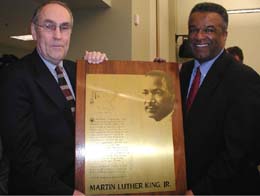Bruce C. Laing, a professional planner, was elected as a Republican to the King County Council in 1979 and spent 16 years on the Council. During his tenure, Laing, a moderate, exhibited an ability to build consensus and get difficult jobs done. He was influential in growth management, transit, and planning issues. His ability to forge consensus was challenged in his effort to develop support for the Regional Transit Authority mass transit plan, including light rail. In this he faced formidable opposition from Eastside developer Kemper Freeman and many others. Although the voters failed to pass it in 1995, a smaller package finally passed in 1996. In its review of his tenure in 1995,
The Seattle Times
hailed Laing's competence, civility, and role as most valuable player on the Council.
A Planner and Consensus Builder
Bruce Laing was born in Seattle on August 17, 1932, son of Robert and Bertha (Huber) Laing. He had two sisters, Kathryn and Elizabeth, and a brother, Robert. He attended Seattle University, receiving a Bachelor of Arts in English Literature, and the University of Washington, where he received a Masters of Urban Planning. He married Brigid Flood and they had three children: Jim, Colleen, and Greg.
After working as a professional planner for engineering, planning, and development firms and with the U.S. Department of Housing and Urban Development, he served as chief zoning and subdivision examiner for King County from 1970-1979. In 1975, he received the Outstanding Public Employee award from the Municipal League of King County.
Elected to the King County Council in 1979, he went to work on a number of land-use and infrastructure issues that were close to his heart. He served on the Metro Council, overseeing the bus and sewage systems of King County, and on the Executive Board of the Puget Sound Council of Governments, a regional planning body.
Sometimes Surprises from a Republican
Allthough he was a Republican and didn't always see eye-to-eye with environmentalists because of his support for many Eastside developments, he also sponsored many progressive, environmentally related measures. He sponsored ordinances to purchase 1,750 acres as part of Cougar Mountain Regional Wildlife Park and a number of other parks measures, along with mitigation for the Cedar Hills Landfill. He also supported recycling as a part of the County's responsibility.
He joined with Democrat Ron Sims to cosponsor redesignation of King County to honor Martin Luther King in 1986 -- the county was originally named in 1852 for Vice President-elect William Rufus de Vane King, a slave owner. In 1988, again as a cosponsor with Sims, he recommended the establishment of a county office to study global warming, a forward-looking act for which the Laing and Sims received scorn from a Seattle Times editorial calling the suggestion "hyperbolic clouds of rhetorical gas." In 2006, the Seattle Times noted that "they're not laughing now" at Sims -- or Laing.
Transit and Conflict
In 1995, the Times staff named Laing and developer Kemper Freeman as among the "People to Watch in '95," as the two prepared to go head-to-head on "the largest bond issue in local history," the proposal to build a $6.7 billion light rail system. The Seattle Times called Laing "the mild-mannered King County councilman who often rides the bus to work" and Freeman "the Bellevue Square developer who favors cars." "Oh sure, there will be more than just these two Eastside Republicans duking it out for the two sides. But the debate may best be summed up in the personalities of Laing and Freeman."
"Laing will lead the good-government, civic and business types favoring the plan.
"Freeman will help finance the opposition, arguing that the system costs too much -- and does too little.
"On March 14, voters will have their say."
That spring, the voters agreed with Freeman, but the light-rail supporters repackaged the plan in a smaller dosage and in 1996 -- partly due to Laing's efforts -- the RTA passed as a $3.9 billion mass transit system.
Most Valuable Player
When he decided not to run for reelection in 1995, a Seattle Times editorial hailed his "legacy of competence" and "civility." In patching together a compromise creating a regional public health board, Laing, the Times noted, was playing his "familiar role of 'Mr. Fix-it.'" The Times continued, "Bruce Laing walks away from a council job with no heir apparent for his role of most valuable player."
Not content to sit on the sidelines, in 1998, Laing continued his public service as Endangered Species Act adviser to the county, with a focus on the potential listing of the Puget Sound Chinook. On November 1, 2003,then-Governor Gary Locke appointed him to the Central Puget Sound Growth Management Hearings Board.

